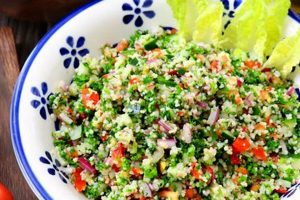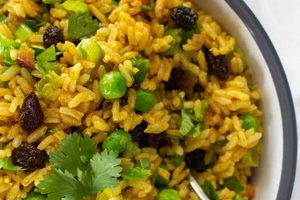A vibrant and refreshing dish from Thai cuisine combines the juicy citrusy segments of pomelo with a complex dressing often featuring fish sauce, lime juice, chilis, and palm sugar. Aromatic herbs like mint and cilantro, along with crunchy peanuts or shallots, frequently contribute textural and flavor complexity. Variations may include dried shrimp, shredded coconut, or other ingredients, reflecting regional preferences and seasonal availability.
This dish offers a balanced culinary experience, contrasting sweet, sour, salty, and spicy flavors. The high vitamin C content of pomelo contributes to its nutritional value. Its light and refreshing nature makes it a popular appetizer or side dish, particularly suited to warm climates. As a staple of Thai cuisine, it provides insight into the countrys culinary heritage, showcasing the skillful blending of fresh ingredients and vibrant flavor profiles.
The following sections delve into specific aspects of this culinary creation, including variations in ingredients and preparation techniques, regional influences, and its place within the broader context of Thai gastronomy.
Tips for Preparing an Excellent Pomelo Salad
Achieving optimal flavor and texture requires attention to detail throughout the preparation process. The following tips offer guidance for creating a truly exceptional salad.
Tip 1: Pomelo Preparation: Thoroughly remove all of the white pith from the pomelo segments. This pith has a bitter taste that can detract from the overall flavor profile. Separate the segments into bite-sized pieces.
Tip 2: Dressing Balance: The balance of sweet, sour, salty, and spicy is crucial. Adjust the proportions of palm sugar, lime juice, fish sauce, and chili to achieve the desired flavor harmony. Taste and adjust as needed.
Tip 3: Ingredient Freshness: Use the freshest ingredients possible. The vibrant flavors of the herbs, chilis, and pomelo are essential to the dish’s success.
Tip 4: Toasting Nuts and Shrimp: Toasting peanuts or other nuts, as well as dried shrimp if used, enhances their flavor and adds a desirable crunch. Do this in a dry pan over medium heat until fragrant and lightly browned.
Tip 5: Chili Handling: Handle fresh chilis with care, wearing gloves if sensitive to their oils. The level of heat can vary; adjust the quantity according to preference.
Tip 6: Combining Ingredients: Gently combine the pomelo segments with the dressing and other ingredients just before serving to prevent the salad from becoming soggy.
Tip 7: Garnishing: A thoughtful garnish elevates the presentation. Consider using fresh cilantro sprigs, toasted coconut flakes, or extra chopped peanuts.
By following these tips, one can create a pomelo salad that showcases the vibrant flavors and textures characteristic of authentic Thai cuisine.
The subsequent section offers further exploration of variations and adaptations of this versatile dish.
1. Fresh Pomelo Segments
Fresh pomelo segments form the heart of a Thai pomelo salad, contributing the defining citrusy sweetness and juicy texture that distinguish the dish. The quality and preparation of these segments directly impact the overall culinary experience. Using pre-packaged or canned pomelo segments, while convenient, often results in a compromised flavor profile lacking the bright, fresh notes of a freshly prepared fruit. The careful removal of all white pith, a bitter membrane surrounding each segment, is essential. This meticulous process ensures a clean, pleasant taste and prevents the salad from becoming overly bitter. Examples of regional variations demonstrate the importance of this ingredient: in some southern Thai preparations, the pomelo is combined with other local citrus fruits, further emphasizing the role of fresh, vibrant citrus flavors.
Beyond flavor, the textural contribution of fresh pomelo segments is vital. The segments offer a burst of juiciness that contrasts with other components in the salad, such as crunchy peanuts, crispy shallots, or dried shrimp. This interplay of textures elevates the dish from simple to complex and satisfying. Furthermore, the structural integrity of fresh segments holds up better in the salad compared to segments that may have been processed or stored improperly. This ensures the salad maintains a pleasant texture and avoids becoming mushy. The visual appeal of plump, glistening pomelo segments also enhances the presentation, making it a more appetizing dish.
Preparation of fresh pomelo segments represents a tangible link to traditional culinary practices. The act of carefully segmenting the fruit, meticulously removing the pith, and gently combining it with other ingredients demonstrates a respect for both the ingredients and the culinary heritage. Challenges may arise in sourcing fresh, high-quality pomelo, particularly outside of Southeast Asia. However, the superior flavor and textural complexity achieved through the use of fresh fruit underscore its importance in an authentic Thai pomelo salad recipe. This understanding allows for informed choices regarding ingredient selection and preparation techniques, ultimately contributing to a more rewarding culinary outcome.
2. Balanced Dressing
Balance within the dressing defines the character of Thai pomelo salad. This balance refers to the harmonious interplay of four fundamental taste profiles: sweet, sour, salty, and spicy. Each element plays a crucial role, and the absence or overemphasis of any one component disrupts the intended flavor profile. The sweetness typically derives from palm sugar, offering a rich, caramelized note that tempers the acidity and heat. Sourness, often contributed by lime juice, provides brightness and cuts through the richness of other ingredients. Fish sauce introduces a savory, umami depth and saltiness that enhances the overall complexity. Finally, the level of spiciness, typically from fresh chilies, adds a piquant dimension, stimulating the palate and balancing the other flavors.
The precise calibration of these elements distinguishes a well-executed dressing. Consider a dressing overly reliant on lime juice; the resulting salad becomes excessively tart, overshadowing the delicate sweetness of the pomelo and other ingredients. Conversely, an overabundance of palm sugar results in a cloying sweetness that masks the other flavors. A skilled preparation involves careful consideration of ingredient proportions and an understanding of how these flavors interact. Regional variations may emphasize certain taste profiles, reflecting local preferences and ingredient availability. For example, salads from southern Thailand often feature a more pronounced spiciness, while those from central Thailand might prioritize a balance of sweet and sour.
Achieving a harmonious balance in the dressing elevates the Thai pomelo salad from a simple combination of ingredients to a complex and nuanced culinary experience. This balance not only enhances the flavor of the individual components but also creates a synergistic effect where the whole becomes greater than the sum of its parts. The interplay of these flavors stimulates the palate, offering a refreshing and satisfying sensory experience. Understanding this dynamic allows for informed adjustments to the dressing, catering to individual preferences and achieving the desired flavor profile. Challenges in achieving this balance may arise from variations in ingredient potency, particularly with chilies and lime juice. Careful tasting and incremental adjustments are crucial to achieving the desired harmony and showcasing the full potential of this classic Thai dish.
3. Aromatic Herbs
Aromatic herbs contribute significantly to the sensory complexity of Thai pomelo salad. Their inclusion extends beyond mere garnish; these herbs play an integral role in shaping the overall flavor profile and aromatic experience. Commonly used herbs include mint, cilantro, and occasionally, Thai basil. These herbs introduce fresh, vibrant notes that contrast and complement the other ingredients. Mint provides a cooling counterpoint to the spiciness of chilies, while cilantro adds a bright, citrusy aroma that enhances the pomelo’s inherent citrus notes. The interplay of these aromatic components elevates the dish beyond the basic flavors of sweet, sour, salty, and spicy, creating a more nuanced and layered sensory experience. For instance, the peppery notes of Thai basil can add another dimension of complexity when used judiciously.
The selection and preparation of these herbs directly impact the final outcome. Fresh, vibrant herbs are essential; wilted or dried herbs lack the potent aromatic oils that contribute significantly to the dish’s character. Proper handling is crucial. Bruising or over-chopping the herbs can release excessive bitterness, negatively impacting the flavor profile. Gentle tearing or light chopping preserves the integrity of the leaves and maximizes their aromatic contribution. Furthermore, the timing of herb incorporation is important. Adding the herbs just before serving ensures their fresh flavors and aromas remain prominent. In some regional variations, specific herbs may be favored, reflecting local culinary traditions and ingredient availability. For example, some southern Thai versions might incorporate sawtooth coriander for its distinctive pungent aroma.
Understanding the role of aromatic herbs in Thai pomelo salad allows for informed choices regarding selection, preparation, and incorporation. This knowledge is crucial for achieving an authentic and balanced flavor profile. The careful interplay of these aromatic elements elevates the dish, transforming it from a simple salad into a complex culinary experience. Challenges may arise in sourcing fresh, high-quality herbs, particularly outside of Southeast Asia. However, recognizing the significance of their contribution encourages prioritization of fresh ingredients, ultimately leading to a more authentic and flavorful representation of this classic Thai dish.
4. Textural Contrasts
Textural contrast is a defining characteristic of Thai pomelo salad, elevating it beyond a simple mixture of flavors. The interplay of various textures creates a dynamic sensory experience, enhancing enjoyment and reflecting the complexity of Thai cuisine. A well-executed salad balances the soft, juicy pomelo segments with a variety of contrasting textures, resulting in a more satisfying and engaging culinary experience. This interplay of textures is not merely incidental; it’s a deliberate culinary strategy that contributes significantly to the dish’s overall appeal.
- Crunchy Elements:
Crunchy elements provide a stark contrast to the soft pomelo. Toasted peanuts, cashews, or fried shallots are frequently incorporated. These additions introduce a satisfying bite, preventing the salad from becoming texturally monotonous. The shattering crispness of these components complements the juiciness of the pomelo, creating a dynamic interplay that stimulates the palate. The specific crunchy element chosen can also influence the overall flavor profile; for instance, peanuts contribute a nutty richness, while shallots offer a savory depth.
- Flaky Components:
Flaky components, such as toasted coconut flakes or dried shrimp, introduce another layer of textural complexity. Toasted coconut adds a subtle sweetness and a delicate crispness, while dried shrimp contribute a savory, umami richness and a chewier texture. These elements further diversify the textural landscape, providing points of interest and preventing the salad from feeling one-dimensional. The delicate nature of these flakes also offers a textural contrast to the more robust crunch of nuts or shallots.
- Soft, Juicy Pomelo:
The soft, juicy segments of pomelo serve as the textural foundation of the salad. Their delicate texture provides a canvas against which the other, contrasting textures play. The segments’ inherent juiciness is essential, not only for flavor but also for how it interacts with the other elements. A dry or pithy pomelo segment would compromise this interplay, diminishing the overall sensory experience.
- Balancing Act:
The success of a Thai pomelo salad relies on the careful balance of these textural elements. Too much crunch can overwhelm the delicate pomelo, while insufficient textural contrast can result in a monotonous dish. The goal is to create a harmonious blend where each texture complements the others, resulting in a dynamic and satisfying culinary experience. This balance reflects a broader principle within Thai cuisine, where textural diversity is highly valued.
The interplay of these varied textures contributes significantly to the overall enjoyment of Thai pomelo salad. It transforms a simple combination of ingredients into a multi-sensory experience, engaging the palate on multiple levels. This attention to textural detail underscores the sophistication and complexity of Thai culinary traditions, showcasing the thoughtful approach to ingredient selection and preparation.
5. Regional Variations
Regional variations within Thai pomelo salad recipes offer a compelling lens through which to examine the diversity and adaptability of Thai cuisine. These variations are not merely superficial changes; they reflect distinct culinary traditions, locally available ingredients, and regional flavor preferences. Understanding these regional nuances provides valuable insight into the complex interplay of culture, geography, and culinary practice within Thailand. Examining these variations also demonstrates how a single dish can evolve and adapt while retaining its core identity.
Specific examples illustrate the tangible impact of regional influences. In southern Thailand, where seafood features prominently, dried shrimp and pungent fish sauce are often incorporated, resulting in a richer, more savory salad. The increased use of chilies in southern Thai cuisine also influences the salad, adding a fiery dimension that reflects local palates. Conversely, variations from central Thailand may emphasize a balance of sweet and sour flavors, often incorporating ingredients like shredded coconut or palm sugar. Northern Thai versions might include toasted peanuts or other locally sourced nuts, reflecting the region’s agricultural products. These variations demonstrate the dynamic relationship between culinary tradition and regional resources. For instance, coastal regions often feature seafood prominently in their salads, while inland areas may emphasize locally grown produce.
Appreciating these regional variations allows for a deeper understanding and appreciation of Thai pomelo salad. Recognizing the connection between ingredients, regional flavors, and culinary traditions provides a richer culinary experience. Furthermore, understanding these variations allows for greater flexibility and creativity in adapting recipes. One can draw inspiration from different regional approaches, incorporating elements that appeal to individual preferences and available ingredients. Challenges may arise in accurately replicating authentic regional variations due to ingredient availability and nuanced preparation techniques. However, acknowledging the existence and significance of these regional differences enriches the culinary experience and fosters a deeper appreciation for the complexity of Thai cuisine as a whole.
6. Authentic Techniques
Authentic techniques are essential for creating a Thai pomelo salad that truly captures the dish’s intended flavor profile and cultural significance. These techniques, passed down through generations, represent a deep understanding of ingredient preparation and flavor balancing. They are not merely procedural steps; they embody a culinary philosophy that prioritizes freshness, balance, and textural complexity. Employing these techniques elevates the salad from a simple combination of ingredients to a nuanced and authentic culinary experience.
- Pomelo Preparation:
The technique of preparing the pomelo significantly impacts the final dish. Authentic recipes emphasize meticulous removal of all the white pith, which can impart bitterness. The segments should be carefully separated, ensuring they remain intact and juicy. This careful handling preserves the pomelo’s delicate texture and clean, citrusy flavor. Skilled practitioners often use a sharp knife to segment the fruit, followed by gentle teasing to remove the pith, demonstrating a respect for the ingredient and a commitment to quality.
- Dressing Preparation:
Authentic Thai pomelo salad dressings rely on a precise balance of sweet, sour, salty, and spicy elements. Traditional techniques involve dissolving palm sugar in lime juice and fish sauce, creating a harmonious blend that coats the pomelo segments evenly. The order of ingredient addition and the method of mixing can influence the final emulsion and flavor distribution. Some regional variations may involve pounding ingredients in a mortar and pestle, releasing aromatic compounds and creating a more complex flavor profile.
- Herb Handling:
The treatment of herbs demonstrates a respect for their delicate nature and aromatic properties. Authentic techniques often involve gently tearing or lightly chopping herbs like mint and cilantro, rather than roughly chopping them. This approach minimizes bruising and preserves the herbs’ fresh flavors and aromas. Adding the herbs just before serving further ensures their vibrant contribution to the finished dish.
- Ingredient Incorporation:
The way ingredients are combined is crucial for maintaining the desired textures and flavors. Authentic techniques emphasize gentle tossing to ensure the pomelo segments remain intact and the dressing is evenly distributed. Overmixing can damage the delicate segments and result in a soggy salad. This careful approach preserves the integrity of each ingredient, allowing the distinct flavors and textures to shine through.
These authentic techniques, when applied thoughtfully, are essential for creating a Thai pomelo salad that truly represents the dish’s culinary heritage and intended flavor profile. They highlight the nuanced understanding of ingredients and flavor balancing characteristic of Thai cuisine. By employing these techniques, one moves beyond simply following a recipe and engages in a culinary practice that honors tradition and maximizes flavor potential. The mastery of these techniques is often a marker of culinary expertise and a testament to the enduring legacy of Thai culinary traditions.
Frequently Asked Questions
This section addresses common inquiries regarding the preparation and appreciation of Thai pomelo salad.
Question 1: Can grapefruit be substituted for pomelo?
While grapefruit can be used as a substitute, it possesses a different flavor profile, often more tart and less nuanced than pomelo. This substitution may result in a salad that deviates significantly from the intended flavor balance.
Question 2: What is the best type of fish sauce to use?
High-quality fish sauce significantly impacts the flavor profile. Authentic Thai fish sauce, typically made from fermented anchovies, is recommended. Lower-quality fish sauces may contain additives or have a less complex flavor profile.
Question 3: How long can the salad be stored?
Optimal flavor and texture are achieved when consumed immediately. Storage is not recommended, as the pomelo segments release moisture and the salad becomes soggy. If storage is necessary, it should be limited to a few hours, refrigerated without the dressing.
Question 4: How can the level of spiciness be adjusted?
Spiciness is controlled by the type and quantity of chili used. Thai bird’s eye chilies offer intense heat; reducing their quantity or removing seeds mitigates spiciness. Alternatively, milder chilies, such as serrano peppers, can be substituted.
Question 5: Where can fresh pomelo be purchased?
Asian grocery stores typically stock fresh pomelos. Availability may vary depending on seasonality and location. Select pomelos that are heavy for their size, with firm skin and a pleasant citrus aroma.
Question 6: Can the dressing be made in advance?
The dressing can be prepared in advance and stored separately. However, combining the dressing with the pomelo and other ingredients just prior to serving preserves the fresh flavors and textures and prevents the salad from becoming watery.
Careful consideration of these frequently asked questions enhances the understanding and successful preparation of this classic Thai dish.
The following section offers further exploration of the cultural significance of Thai pomelo salad.
Thai Pomelo Salad Recipe
Exploration of this vibrant Thai dish reveals a complex interplay of flavors, textures, and culinary techniques. From the careful selection and preparation of fresh pomelo segments to the harmonious balance within the dressing, each component contributes to the dish’s distinctive character. Aromatic herbs, crunchy textural elements, and regional variations further enhance its complexity, reflecting the diversity of Thai culinary traditions. Authentic techniques, passed down through generations, underscore the importance of precise execution in achieving optimal flavor and texture. The careful balance of sweet, sour, salty, and spicy elements within the dressing exemplifies the nuanced approach to flavor characteristic of Thai cuisine. The inclusion of fresh herbs and textural components elevates the dish beyond a simple salad, transforming it into a multi-sensory culinary experience.
Thai pomelo salad represents more than just a recipe; it embodies a culinary philosophy that prioritizes fresh ingredients, balanced flavors, and textural complexity. Further exploration of regional variations offers a deeper appreciation for the adaptability and cultural significance of this dish within the broader context of Thai gastronomy. Culinary enthusiasts are encouraged to embrace the opportunity to experience the vibrant flavors and textures of this classic Thai creation, recognizing its embodiment of culinary artistry and cultural heritage.






